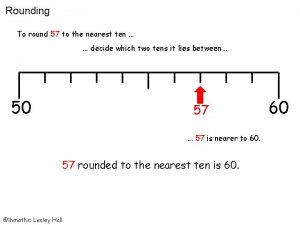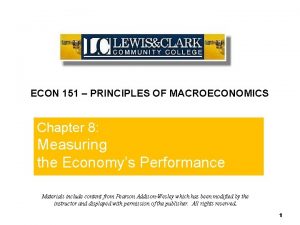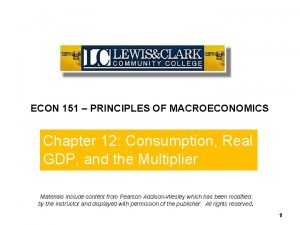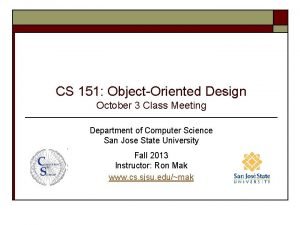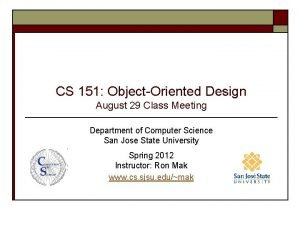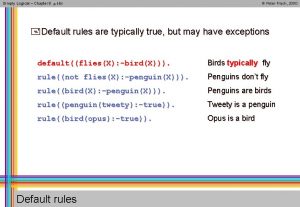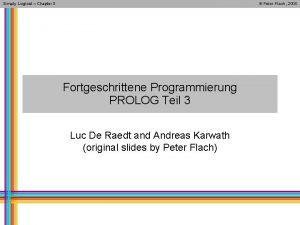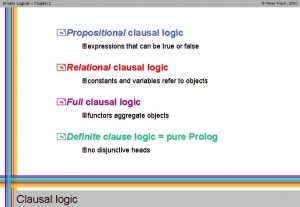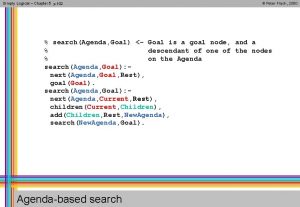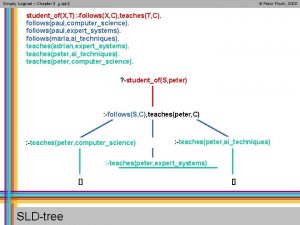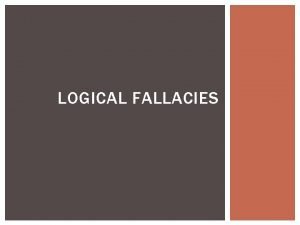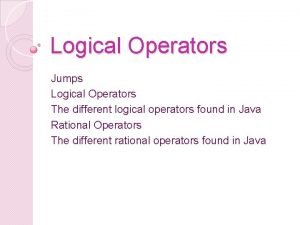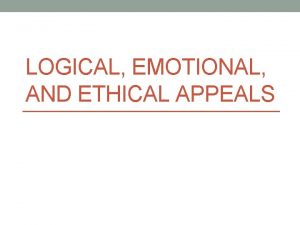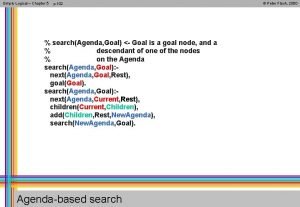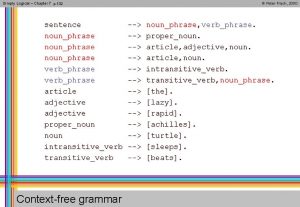Simply Logical Chapter 8 p 151 Peter Flach
























- Slides: 24

Simply Logical – Chapter 8 p. 151 © Peter Flach, 2000 +Default rules are typically true, but may have exceptions default((flies(X): -bird(X))). Birds typically fly rule((not flies(X): -penguin(X))). Penguins don’t fly rule((bird(X): -penguin(X))). Penguins are birds rule((penguin(tweety): -true)). Tweety is a penguin rule((bird(opus): -true)). Opus is a bird Default rules

Simply Logical – Chapter 8 p. 152 explain(true, E, E): -!. explain((A, B), E 0, E): -!, explain(A, E 0, E 1), explain(B, E 1, E). explain(A, E 0, E): prove_e(A, E 0, E). % explain by rules only explain(A, E 0, [default((A: -B))|E]): default((A: -B)), % explain by default explain(B, E 0, E), not contradiction(A, E). % A consistent with E contradiction(not A, E): -!, prove_e(A, E, _). contradiction(A, E): prove_e(not A, E, _). Meta-interpreter for default rules © Peter Flach, 2000

Simply Logical – Chapter 8 p. 153 © Peter Flach, 2000 default(mammals_dont_fly(X), (not flies(X): -mammal(X))). default(bats_fly(X), (flies(X): -bat(X))). default(dead_things_dont_fly(X), (not flies(X): -dead(X))). rule((mammal(X): -bat(X))). rule((bat(dracula): -true)). rule((dead(dracula): -true)). % Cancellation rules: % bats are flying mammals rule((not mammals_dont_fly(X): -bat(X))). % dead bats don’t fly rule((not bats_fly(X): -dead(X))). Does Dracula fly or not?

Simply Logical – Chapter 8 p. 153 © Peter Flach, 2000 explain(true, E, E): -!. explain((A, B), E 0, E): -!, explain(A, E 0, E 1), explain(B, E 1, E). explain(A, E 0, E): prove_e(A, E 0, E). % explain by rules only explain(A, E 0, [default(Name)|E]): default(Name, (A: -B)), % explain by default rule explain(B, E 0, E), not contradiction(Name, E), % default should be applicable not contradiction(A, E). % A should be consistent with E Extended meta-interpreter for named defaults

Simply Logical – Chapter 8 p. 154 © Peter Flach, 2000 default(mammals_dont_fly(X), (not flies(X): -mammal(X))). default(bats_fly(X), (flies(X): -bat(X))). default(dead_things_dont_fly(X), (not flies(X): -dead(X))). rule((mammal(X): -bat(X))). rule((bat(dracula): -true)). rule((dead(dracula): -true)). rule((not mammals_dont_fly(X): -bat(X))). rule((not bats_fly(X): -dead(X))). ? -explain(flies(dracula), [], E). No ? -explain(not flies(dracula), [], E). E = [ default(dead_things_dont_fly(dracula)), rule((dead(dracula): -true)) ] Dracula doesn’t fly after all

Simply Logical – Chapter 8 p. 167 © Peter Flach, 2000 +For each default name, introduce a predicate introducing the opposite (‘abnormality predicate’) bats_fly(X) becomes nonflying_bat(X) +Add this predicate as a negative condition default(bats_fly(X), (flies(X): -bat(X))) becomes flies(X): -bat(X), not nonflying_bat(X) +Introduce new predicate for negated conclusions default(dead_things_don’t_fly(X), (not flies(X): dead(X))) becomes notflies(X): -dead(X), not flying_deadthing(X) Defaults using negation as failure

Simply Logical – Chapter 8 p. 167 © Peter Flach, 2000 default(mammals_dont_fly(X), (not flies(X): -mammal(X))). default(bats_fly(X), (flies(X): -bat(X))). default(dead_things_dont_fly(X), (not flies(X): -dead(X))). rule((mammal(X): -bat(X))). rule((bat(dracula): -true)). rule((dead(dracula): -true)). rule((not mammals_dont_fly(X): -bat(X))). rule((not bats_fly(X): -dead(X))). notflies(X): -mammal(X), not flying_mammal(X). flies(X): -bat(X), not nonflying_bat(X). notflies(X): -dead(X), not flying_deadthing(X). mammal(X): -bat(X). bat(dracula). dead(dracula). flying_mammal(X): -bat(X). nonflying_bat(X): -dead(X). Dracula again

Simply Logical – Chapter 8 p. 154 © Peter Flach, 2000 + Incompleteness arises when assumptions regarding a domain are not explicitly represented in a logic program P. + There are several ways to make these assumptions explicit: 3 by selecting one of the models of P as the intended model 3 by transforming P into the intended program • Closed World Assumption • Predicate Completion + New information can invalidate previous conclusions if they were based on assumptions 3 non-monotonic reasoning Semantics of incomplete information

Simply Logical – Chapter 8 p. 148 © Peter Flach, 2000 flies(X); abnormal(X): -bird(X). bird(tweety). f, b, a f, b f, a b, a f b a flies(X): -bird(X), not abnormal(X). Selecting an intended model abnormal(X): -bird(X), not flies(X).

Simply Logical – Chapter 8 p. 154 -5 © Peter Flach, 2000 CWA(P) = P {: -A | A Herbrand base, A is not a logical consequence of P} likes(peter, S): student_of(S, peter). student_of(paul, peter). CWA : -student_of(paul, paul). : -student_of(peter, peter). : -likes(paul, paul). : -likes(paul, peter). : -likes(peter, peter). Closed World Assumption likes(peter, S): student_of(S, peter). student_of(paul, peter). likes(paul, X). CWA : -student_of(paul, paul). : -student_of(peter, peter). : -likes(peter, peter).

Simply Logical – Chapter 8 p. 156 © Peter Flach, 2000 + Step 1: rewrite clauses such that the head contains only distinct variables, by adding literals Var=Term to the body + Step 2: for each head predicate, combine its clauses into a single universally quantified implication with disjunctive body 3 take care of existential variables + Step 3: turn all implications into equivalences 3 undefined predicates p are rewritten to X: p(X) + (Step 4: rewrite as general clauses) Predicate Completion

Simply Logical – Chapter 8 p. 157 likes(peter, S): -student_of(S, peter). student_of(paul, peter). likes(X, S): -X=peter, student_of(S, peter). student_of(X, Y): -X=paul, Y=peter. X Y: likes(X, Y) (X=peter student_of(Y, peter)) X Y: student_of(X, Y) (X=paul Y=peter) likes(peter, S): -student_of(S, peter). X=peter: -likes(X, S). student_of(S, peter): -likes(X, S). student_of(paul, peter). X=paul: -student_of(X, Y). Y=peter: -student_of(X, Y). Predicate Completion © Peter Flach, 2000

Simply Logical – Chapter 8 p. 157 © Peter Flach, 2000 ancestor(X, Y): -parent(X, Y). ancestor(X, Y): -parent(X, Z), ancestor(Z, Y). X Y: ancestor(X, Y) ( parent(X, Y) ( Z: parent(X, Z) ancestor(Z, Y)) ) ancestor(X, Y): -parent(X, Y). ancestor(X, Y): -parent(X, Z), ancestor(Z, Y). parent(X, Y); parent(X, pa(X, Y)): -ancestor(X, Y). parent(X, Y); ancestor(pa(X, Y): -ancestor(X, Y). Completion with existential variables

Simply Logical – Chapter 8 p. 158 © Peter Flach, 2000 bird(tweety). flies(X): -bird(X), not abnormal(X). bird(X): -X=tweety. flies(X): -bird(X), not abnormal(X). X: bird(X) X=tweety X: flies(X) ( bird(X) abnormal(X) ) X: abnormal(X) bird(tweety). X=tweety: -bird(X). flies(X); abnormal(X): -bird(X): -flies(X), abnormal(X). : -abnormal(X). Completion with negation

Simply Logical – Chapter 8 p. 158 © Peter Flach, 2000 wise(X): -not teacher(X). teacher(peter): -wise(peter). wise(X): -not teacher(X): -X=peter, wise(peter). X: wise(X) teacher(X) X: teacher(X) ( X=peter wise(peter) ) wise(X); teacher(X). : -wise(X), teacher(X). teacher(peter): -wise(peter). X=peter: -teacher(X). wise(peter): -teacher(X). Exercise 8. 3 inconsistent!

Simply Logical – Chapter 8 p. 159 © Peter Flach, 2000 Abduction: given a Theory and an Observation, find an Explanation such that the Observation is a logical consequence of Theory Explanation % abduce(O, E 0, E) <E is abductive explanation of O, given E 0 abduce(true, E, E): -!. abduce((A, B), E 0, E): -!, abduce(A, E 0, E 1), abduce(B, E 1, E). abduce(A, E 0, E): clause(A, B), abduce(B, E 0, E). abduce(A, E, E): - % already assumed element(A, E). abduce(A, E, [A|E]): % A can be added to E not element(A, E), % if it's not already there, abducible(A). % and if it's abducible(A): -not clause(A, _). Abductive meta-interpreter

Simply Logical – Chapter 8 p. 160 © Peter Flach, 2000 likes(peter, S): -student_of(S, peter). likes(X, Y): -friend(Y, X). ? -abduce(likes(peter, paul), [], E). E = [student_of(paul, peter)] ; E = [friend(paul, peter)] flies(X): -bird(X), not abnormal(X): -penguin(X). bird(X): -sparrow(X). ? -abduce(flies(tweety), [], E). E = [not abnormal(tweety), penguin(tweety)] ; % WRONG!!! E = [not abnormal(tweety), sparrow(tweety)] Abduction: examples

Simply Logical – Chapter 8 p. 161 © Peter Flach, 2000 abduce(true, E, E): -!. abduce((A, B), E 0, E): -!, abduce(A, E 0, E 1), abduce(B, E 1, E). abduce(A, E 0, E): clause(A, B), abduce(B, E 0, E). abduce(A, E, E): element(A, E). % already assumed abduce(A, E, [A|E]): % A can be added to E not element(A, E), % if it's not already there, abducible(A), % if it's abducible, not abduce_not(A, E, E). % and E doesn't explain not(A) abduce(not(A), E 0, E): - % find explanation for not(A) not element(A, E 0), % should be consistent abduce_not(A, E 0, E). Abduction with negation

Simply Logical – Chapter 8 p. 162 © Peter Flach, 2000 % abduce_not(O, E 0, E) <- E is abductive explanation of not(O) abduce_not((A, B), E 0, E): -!, abduce_not(A, E 0, E); % disjunction abduce_not(B, E 0, E). abduce_not(A, E 0, E): setof(B, clause(A, B), L), abduce_not_l(L, E 0, E). abduce_not(A, E, E): element(not(A), E). % not(A) already assumed abduce_not(A, E, [not(A)|E]): % not(A) can be added to E not element(not(A), E), % if it's not already there, abducible(A), % if A is abducible not abduce(A, E, E). % and E doesn't explain A abduce_not(A), E 0, E): % find explanation for A not element(not(A), E 0), % should be consistent abduce(A, E 0, E). Explaining negative literals

Simply Logical – Chapter 8 p. 160 © Peter Flach, 2000 flies(X): -bird(X), not abnormal(X). flies 1(X): -not abnormal(X), bird(X). abnormal(X): -penguin(X). abnormal(X): -dead(X). bird(X): -penguin(X). bird(X): -sparrow(X). ? -abduce(flies(tweety), [], E). E = [not penguin(tweety), not dead(tweety), sparrow(tweety)] ? -abduce(flies 1(tweety), [], E). E = [sparrow(tweety), not penguin(tweety), not dead(tweety)] Abduction with negation: example

Simply Logical – Chapter 8 p. 160 © Peter Flach, 2000 notflies(X): -mammal(X), not flying_mammal(X). flies(X): -bat(X), not nonflying_bat(X). notflies(X): -dead(X), not flying_deadthing(X). mammal(X): -bat(X). bat(dracula). dead(dracula). flying_mammal(X): -bat(X). nonflying_bat(X): -dead(X). ? -abduce(flies(X), [], E). No ? -abduce(notflies(X), [], E). E = [not flying_deadthing(dracula)] Abduction generalises negation as failure

Simply Logical – Chapter 8 Fig. 8. 3, p. 164 © Peter Flach, 2000 X Y xor 1 S xor 2 Sum Z and 1 C 1 or 1 and 2 3 -bit adder C 2 Carry

Simply Logical – Chapter 8 p. 164 -5 adder(N, X, Y, Z, Sum, Carry): xorg(N-xor 1, X, Y, S), xorg(N-xor 2, Z, S, Sum), andg(N-and 1, X, Y, C 1), andg(N-and 2, Z, S, C 2), org(N-or 1, C 2, Carry). © Peter Flach, 2000 % N-xor 1 is the name of this gate X Y xor 1 S xor 2 Z and 1 % fault model (similar for andg, org) xorg(N, X, Y, Z): -xor(X, Y, Z). % normal operation xorg(N, 1, 1, 1): -fault(N=s 1). % stuck at 1 xorg(N, 0, 0, 1): -fault(N=s 1). % stuck at 1 xorg(N, 1, 0, 0): -fault(N=s 0). % stuck at 0 xorg(N, 0, 1, 0): -fault(N=s 0). % stuck at 0 % gates (similar for and, or) xor(1, 0, 1). xor(0, 1, 1). xor(1, 1, 0). xor(0, 0, 0). 3 -bit adder in Prolog Sum C 1 or 1 and 2 Carry

Simply Logical – Chapter 8 p. 164 -5 © Peter Flach, 2000 X Y xor 1 S xor 2 Sum Z and 1 C 1 ? -abduce(adder(a, 0, 0, 1), [], D). D = [fault(a-or 1=s 1), fault(a-xor 2=s 0)]; D D D D = = = = or 1 and 2 C 2 [fault(a-and 2=s 1), fault(a-xor 2=s 0)]; [fault(a-and 1=s 1), fault(a-xor 2=s 0)]; [fault(a-and 2=s 1), fault(a-and 1=s 1), fault(a-xor 2=s 0)]; [fault(a-xor 1=s 1)]; [fault(a-or 1=s 1), fault(a-and 2=s 0), fault(a-xor 1=s 1)]; [fault(a-and 1=s 1), fault(a-xor 1=s 1)]; [fault(a-and 2=s 0), fault(a-and 1=s 1), fault(a-xor 1=s 1)]; No more solutions Abductive diagnosis Carry
 Henrik flach
Henrik flach Flach mobile
Flach mobile Jan philipps
Jan philipps Logical operators equivalence
Logical operators equivalence Logical equivalence in discrete mathematics
Logical equivalence in discrete mathematics 151 to the nearest hundred
151 to the nearest hundred Chemistry 151 final exam
Chemistry 151 final exam Model netics
Model netics Hino 151
Hino 151 Econ 151
Econ 151 A software consists of
A software consists of 118/151
118/151 Cs 175 uci
Cs 175 uci Tổng kết vốn từ 151
Tổng kết vốn từ 151 Immurel
Immurel Apsc 151
Apsc 151 1,151,725 bytes
1,151,725 bytes 151 food
151 food Melissa reedy uiuc
Melissa reedy uiuc Gdp formula
Gdp formula Scia antincendio esempio
Scia antincendio esempio Econ 151
Econ 151 Sjsu cs 151
Sjsu cs 151 Cs 151 sjsu
Cs 151 sjsu Slidetodoc
Slidetodoc





